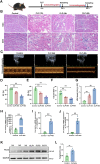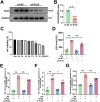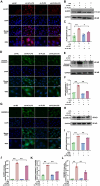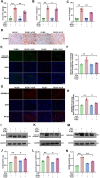PLD2 deletion ameliorates sepsis-induced cardiomyopathy by suppressing cardiomyocyte pyroptosis via the NLRP3/caspase 1/GSDMD pathway
- PMID: 38630134
- PMCID: PMC11106193
- DOI: 10.1007/s00011-024-01881-w
PLD2 deletion ameliorates sepsis-induced cardiomyopathy by suppressing cardiomyocyte pyroptosis via the NLRP3/caspase 1/GSDMD pathway
Abstract
Objective: Sepsis-induced cardiomyopathy (SICM) is a life-threatening complication. Phospholipase D2 (PLD2) is crucial in mediating inflammatory reactions and is associated with the prognosis of patients with sepsis. Whether PLD2 is involved in the pathophysiology of SICM remains unknown. This study aimed to investigate the effect of PLD2 knockout on SICM and to explore potential mechanisms.
Methods: The SICM model was established using cecal ligation and puncture in wild-type and PLD2-knockout mice and lipopolysaccharide (LPS)-induced H9C2 cardiomyocytes. Transfection with PLD2-shRNA lentivirus and a PLD2 overexpression plasmid were used to interfere with PLD2 expression in H9C2 cells. Cardiac pathological alterations, cardiac function, markers of myocardial injury, and inflammatory factors were used to evaluate the SICM model. The expression of pyroptosis-related proteins (NLRP3, cleaved caspase 1, and GSDMD-N) was assessed using western blotting, immunofluorescence, and immunohistochemistry.
Results: SICM mice had myocardial tissue damage, increased inflammatory response, and impaired heart function, accompanied by elevated PLD2 expression. PLD2 deletion improved cardiac histological changes, mitigated cTNI production, and enhanced the survival of the SICM mice. Compared with controls, PLD2-knockdown H9C2 exhibits a decrease in inflammatory markers and lactate dehydrogenase production, and scanning electron microscopy results suggest that pyroptosis may be involved. The overexpression of PLD2 increased the expression of NLRP3 in cardiomyocytes. In addition, PLD2 deletion decreased the expression of pyroptosis-related proteins in SICM mice and LPS-induced H9C2 cells.
Conclusion: PLD2 deletion is involved in SICM pathogenesis and is associated with the inhibition of the myocardial inflammatory response and pyroptosis through the NLRP3/caspase 1/GSDMD pathway.
Keywords: Caspase 1; GSDMD; NLRP3; Phospholipase D2; Pyroptosis; Sepsis-induced cardiomyopathy.
© 2024. The Author(s).
Conflict of interest statement
The authors assert that they do not own any conflicting interest.
Figures








Similar articles
-
Chinese medicinal formula Fu Xin decoction against chronic heart failure by inhibiting the NLRP3/caspase-1/GSDMD pyroptotic pathway.Biomed Pharmacother. 2024 May;174:116548. doi: 10.1016/j.biopha.2024.116548. Epub 2024 Apr 9. Biomed Pharmacother. 2024. PMID: 38599064
-
Cardiac Resolvin D2 ameliorates sepsis-induced cardiomyopathy via inhibiting Caspase-11/GSDMD dependent pyroptosis.Free Radic Biol Med. 2024 Mar;215:64-76. doi: 10.1016/j.freeradbiomed.2024.02.026. Epub 2024 Mar 2. Free Radic Biol Med. 2024. PMID: 38437927
-
[Electroacupuncture improves colonic mucosal barrier damage by regulating NLRP3/Caspase-1/GSDMD signaling pathway and inhibiting pyroptosis in ulcerative colitis mice].Zhen Ci Yan Jiu. 2025 Mar 25;50(3):277-286. doi: 10.13702/j.1000-0607.20240402. Zhen Ci Yan Jiu. 2025. PMID: 40103379 Chinese.
-
Pyroptosis and Its Role in SARS-CoV-2 Infection.Cells. 2022 May 23;11(10):1717. doi: 10.3390/cells11101717. Cells. 2022. PMID: 35626754 Free PMC article. Review.
-
O-GlcNAcylation dictates pyroptosis.Front Immunol. 2024 Dec 17;15:1513542. doi: 10.3389/fimmu.2024.1513542. eCollection 2024. Front Immunol. 2024. PMID: 39742284 Free PMC article. Review.
Cited by
-
Pancreatic stone protein inhibits pyroptosis of pancreatic acinar cells in sepsis-associated pancreatic injury.Front Med (Lausanne). 2025 Jul 10;12:1566728. doi: 10.3389/fmed.2025.1566728. eCollection 2025. Front Med (Lausanne). 2025. PMID: 40708650 Free PMC article.
-
Minocycline alleviates lipopolysaccharide-induced cardiotoxicity by suppressing the NLRP3/Caspase-1 signaling pathway.Sci Rep. 2024 Sep 11;14(1):21180. doi: 10.1038/s41598-024-72133-4. Sci Rep. 2024. PMID: 39261543 Free PMC article.
-
NLRP3 Inflammasome Targeting Offers a Novel Therapeutic Paradigm for Sepsis-Induced Myocardial Injury.Drug Des Devel Ther. 2025 Feb 14;19:1025-1041. doi: 10.2147/DDDT.S506537. eCollection 2025. Drug Des Devel Ther. 2025. PMID: 39967903 Free PMC article. Review.
-
Diagnostic and Predictive Value of LncRNA MCM3AP-AS1 in Sepsis and Its Regulatory Role in Sepsis-Induced Myocardial Dysfunction.Cardiovasc Toxicol. 2024 Oct;24(10):1125-1138. doi: 10.1007/s12012-024-09903-z. Epub 2024 Jul 31. Cardiovasc Toxicol. 2024. PMID: 39085530
-
p16INK4a Aggravated Sepsis-associated Cardiac Injury by Inhibiting the PI3K/AKT Pathway and Inducing Redox Imbalance.J Cardiovasc Transl Res. 2025 Apr;18(2):375-391. doi: 10.1007/s12265-024-10588-6. Epub 2025 Jan 14. J Cardiovasc Transl Res. 2025. PMID: 39809973
References
MeSH terms
Substances
Grants and funding
LinkOut - more resources
Full Text Sources
Medical
Research Materials

